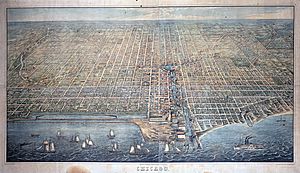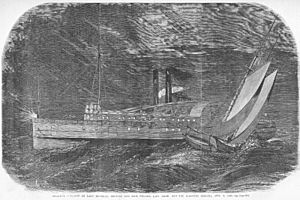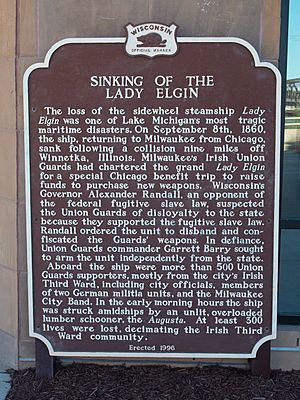PS Lady Elgin facts for kids
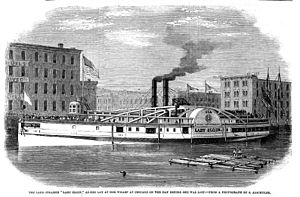
Lady Elgin at Dock September 7, 1860
|
|
Quick facts for kids History |
|
|---|---|
| Name | Lady Elgin |
| Operator | Gurdon Saltonstall Hubbard |
| Builder |
|
| Completed | 1851 |
| Fate | Sunk in collision with schooner Augusta of Oswego September 8, 1860 |
| Notes | First enrollment issued at Buffalo, New York November 5, 1851 |
| General characteristics | |
| Class and type | Sidewheel steamer - passengers and package freight |
| Tonnage | 1037.70 gross |
| Length | 252 ft (77 m) |
| Beam | 32.66 ft (9.95 m) |
| Height | 13 ft (4.0 m) |
| Notes | Wood hull vessel |
The PS Lady Elgin was a large sidewheel steamship with a wooden hull. She sank in Lake Michigan on September 8, 1860. This happened after she was hit by a schooner called Augusta during a strong storm. The accident occurred near what is now Highland Park, Illinois and Highwood, Illinois.
Many people were on board, but the passenger list was lost. About 300 lives were lost in the sinking. This made it one of the worst ship disasters ever recorded at the time. Four years later, a new rule was made. It required all sailing ships to use special lights at night. The Lady Elgin disaster is still the biggest loss of life on open water in the history of the Great Lakes.
In 1994, people tried to add the shipwreck to the National Register of Historic Places. It was found to be worthy in 1999. However, the owner objected, so it was not officially listed.
Contents
The Story of the Lady Elgin
Building and Early Life of the Ship
The Lady Elgin was built in 1851 in Buffalo, New York. It cost $95,000 to build her. She was named after the wife of Lord Elgin. He was Canada's Governor General from 1847 to 1854.
At the time, the Lady Elgin was one of the most beautiful passenger ships. She sailed on the Great Lakes. People loved traveling on her. She was considered a top-class steamer.
Early on, she traveled between Buffalo and Chicago. Later, she sailed between Chicago and Collingwood, Ontario. For many years, she also traveled between Chicago and other ports on Lake Michigan and Lake Superior.
Accidents Before the Final Voyage
The Lady Elgin had many accidents during her time.
- In 1854, she hit a rock near Manitowoc, Wisconsin and sank. She was later repaired.
- In 1855, her machinery broke down. She had to be towed to Chicago.
- In 1857, she was damaged by a fire.
- In June 1858, she hit a reef at Copper Harbor, Michigan.
- In August 1858, she got stuck on Au Sable Point Reef in Lake Superior.
- In October 1859, her crossbeam broke. She was towed to Marquette, Michigan.
- In November 1859, her crank pin broke near Point Iroquois, Michigan. She was towed again.
Her last accident was in 1860. She was hit by the schooner Augusta ten miles from shore. A historian named J.B. Mansfield called her sinking "one of the greatest marine horrors on record."
The Final Journey of the Lady Elgin
On the evening of September 6, 1860, the Lady Elgin left Milwaukee, Wisconsin. She was heading to Chicago. Many passengers were members of Milwaukee's Union Guard. They were going to hear a speech by Stephen A. Douglas. He was running against Abraham Lincoln.
On September 7, people listened to speeches all day. In the evening, a German brass band played on the Lady Elgin. On the way back that night, the ship was brightly lit. She was sailing through Lake Michigan in strong gale force winds.
At 2:30 AM on September 8, the schooner Augusta of Oswego hit the Lady Elgin. The Augusta was only using one white light on its front. It did not try to turn away from the Lady Elgin in the storm. The Augusta crashed into the left side of the Lady Elgin. This made a large hole below the water line.
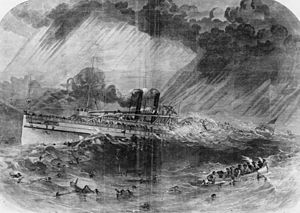
The captain of the Augusta, Darius Malott, thought the Lady Elgin had gotten away safely. So, the Augusta headed for Chicago. On the Lady Elgin, Captain Wilson told his crew to throw cattle and cargo overboard. He hoped this would lighten the ship and raise the hole above the water. The steward tried to stop the leak with mattresses.
Captain Wilson ordered a lifeboat to be lowered. He wanted to check the damage. But the lifeboat never made it back to the steamer. Within twenty minutes, the Lady Elgin broke apart. Most of the ship quickly sank. Lightning flashed, showing pieces of the wreckage in the dark.
The ship's life preservers were never used. They were 2 in (5.1 cm) thick wooden planks. Only two small boats with 18 people reached the shore. Fourteen people were saved on a large raft. Many others held onto parts of the wreckage.
About 98 people were saved, but over 300 lives were lost. Charles Beverung, the drummer of the German band, saved himself. He used his large bass drum to float. Survivors said Captain Wilson tried to save about 300 people on a raft. When morning came, many people were still in the stormy water. They held onto anything they could. But many were pulled under by waves near the shore.
Students from Northwestern University and Garrett Biblical Institute watched the shore. They were looking for survivors on September 8. One student, Edward Spencer, saved 17 passengers over six hours. He was hurt during his rescue efforts. These injuries affected him for the rest of his life. A special plaque honors him at the Northwestern University Library.
About 300 people died in the sinking. This included Captain Wilson. He was lost trying to save two women. Most of the people who died were from Milwaukee. Many were from the Irish communities there. This included almost all of Milwaukee's Irish Union Guard. It is believed that fewer than 40 children were orphaned by this tragedy. The Lady Elgin disaster remains the greatest loss of life on open water in Great Lakes history.
Remembering the Lady Elgin
There is a historical marker in Milwaukee's historic Third Ward. It remembers the Lady Elgin tragedy. Calvary Cemetery in Milwaukee has a monument. It honors those lost in the disaster who are buried there.
A songwriter named Henry Clay Work wrote a song about the event in 1861. It was called "Lost on the Lady Elgin." For many years, people in central Canada sang this song. They sang it at family gatherings and social events.
In 2009, the Milwaukee Irish Heritage and Cultural Center started a project. They wanted to raise $200,000 for a large bronze statue. This statue would be a memorial for the Lady Elgin disaster.
Rules for Ships After the Disaster
After the sinking, the Lady Elgin's owner, Gurdon Saltonstall Hubbard, received $12,000 from his insurance company. The captain of the Augusta, Darius Malott, was questioned in Chicago. He was found not responsible for the collision.
An investigation found that a main reason for the crash was the lack of a light on the Augusta. At that time, sailing ships were not required to carry special lights at night. The Augusta had seen the Lady Elgin twenty minutes before the crash. But in the rain, they misjudged how far away it was.
Four years after the disaster, in 1864, a new rule was made. It required all sailing vessels to carry running lights. This rule was very important. There were still almost 1,900 sailing ships by 1870.
The Wreck of the Lady Elgin
The wreck of the Lady Elgin was found in 1989. It was located off Highwood, Illinois, by Harry Zych. He was given ownership of the wreck in 1999 after a long legal process.
The wreck is made up of four main areas of debris. It lies in 50 and 60 feet (15 and 18 m) of water. Over the years, many items have been taken from the wreck. Divers need permission from Harry Zych and the Lady Elgin Foundation to visit the site. They must also follow laws that protect historic sites. The Underwater Archaeological Society of Chicago studied the wreck site in 1992.


